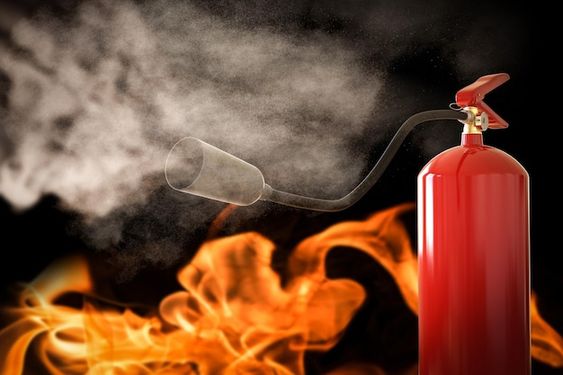Last Updated on March 24, 2024 by Allen
No, fire extinguisher powder is not toxic and is safe for home and vehicle use. However, inhaling or ingesting the powder can cause respiratory and digestive irritation, respectively. Direct contact may also irritate skin and eyes. It is recommended to wear protective gear when cleaning and handling to reduce the chance of exposure.

Composition and Uses
You may find that fire extinguisher powder, composed of various chemicals, serves as an effective tool for combating fires of different types. This powder is commonly made of substances like monoammonium phosphate, sodium bicarbonate, or potassium bicarbonate.
Each chemical works by interrupting the chemical reaction of the fire triangle, effectively extinguishing the flames. Monoammonium phosphate, for instance, is effective for combating Class A, B, and C fires, making it a vital choice for many situations. Sodium bicarbonate is particularly useful for kitchen fires involving grease or oil due to its ability to smother the flames.
To use the appropriate type of fire extinguisher powder in an emergency and ensure that you can put out fires safely and effectively, you must understand the composition of the powder.
Health and Safety Concerns
Concerns regarding possible health and safety hazards should be considered when using fire extinguisher powder.
Inhalation of the powder can lead to respiratory irritation, while ingestion may cause gastrointestinal issues.
Additionally, direct contact with the eyes and skin can result in irritation and discomfort.
Inhalation
Inhaling fire extinguisher powder can pose serious health risks due to its chemical composition. When you inhale this powder, it can lead to various health issues. Here are some potential consequences:
- Essential: The powder can irritate your respiratory tract, causing coughing, wheezing, and difficulty breathing.
- Vital Damage: Inhaling the powder particles can result in lung inflammation and damage, affecting your ability to breathe properly.
- Critical Reactions: Some individuals may experience allergic reactions when exposed to the powder, leading to symptoms like itching, redness, or swelling.
It is essential to avoid inhaling fire extinguisher powder to prevent these health complications. If accidental inhalation occurs, seek medical attention promptly.
Ingestion
Ingesting fire extinguisher powder can result in severe health risks due to its toxic properties. If accidentally ingested, the chemicals in the powder can cause irritation and damage to the digestive tract. Symptoms may include nausea, vomiting, abdominal pain, and diarrhea.
In more severe cases, ingestion could lead to difficulty breathing, seizures, or even organ failure. It’s vital to seek immediate medical attention if ingestion occurs. Don’t induce vomiting unless instructed by a healthcare professional, as it can worsen the situation. Remember to provide as much detail as possible to healthcare providers about the type of extinguisher powder ingested, as different formulations may require specific treatments.
Keep all fire safety products, including extinguishers, out of reach of children and pets to prevent accidental ingestion.
Contact with Eyes and Skin
Contact with eyes and skin can result in immediate irritation and potential damage when exposed to fire extinguisher powder. Here are some effects you may experience:
- Eyes: Redness, stinging sensation, and watering may occur upon contact with the powder.
- Skin: Skin contact can lead to irritation, itching, and possibly a burning sensation.
- Allergic Reactions: Some individuals may be more sensitive to the powder, experiencing severe allergic reactions such as swelling, hives, or even difficulty breathing.
Toxicity Concerns for Pets and Wildlife
Exposure to fire extinguisher powder can pose a potential threat to pets and wildlife due to its toxic properties. The powder contains chemicals like monoammonium phosphate or potassium bicarbonate, which can be harmful if ingested or inhaled by animals.
When pets or wildlife come into contact with fire extinguisher powder, they may experience symptoms such as vomiting, diarrhea, difficulty breathing, or skin irritation. Ingesting the powder could lead to more severe issues like organ damage or respiratory problems.
It’s essential to keep pets away from areas where fire extinguisher powder has been discharged and to promptly clean up any spills or residues to prevent accidental exposure. If you suspect your pet has been exposed, contact a veterinarian immediately for guidance on proper treatment.
Handling and Cleanup
To avoid any possible harm to people, pets, or wildlife, it’s crucial to know how to handle and dispose of fire extinguisher powder correctly.
Here are some steps to guide you through the process:
- Wear protective gear such as gloves and a mask to avoid direct contact with the powder.
- Use a vacuum cleaner with a HEPA filter to carefully remove the powder from surfaces.
- Dispose of the collected powder in a sealed bag or container to prevent further spread of the substance.
By following these easy steps, you can reduce the risks to the environment and its inhabitants and ensure a safe and efficient cleanup of fire extinguisher powder.






